List of apple cultivars

Over 7,500 cultivars of the apple are known.[1] In the following list, use for "eating" means that the fruit is used fresh, rather than cooked. Cultivars used primarily for making cider are indicated. Those varieties marked agm have gained the Royal Horticultural Society's Award of Garden Merit.
Table of apples
| Common name | Image | Origin | First developed | Comment | Use |
|---|---|---|---|---|---|
| Adams Pearmain |  |
England | 1826 | A dessert apple. Similar flavour to Russet, first introduced under the name "Norfolk Pippin". | Eating |
| Admiral |  |
Czech Republic | 2012 | New very popular variety.Flesh firm, crisp, juicy with very good taste. Robust, healthy, scab resistant variety with excellent keeping qualities and taste. | Eating |
| Aia Ilu | Estonia | 1946 | Apple is large in size, weighing 250–300 g. It is yellow, juicy, and bittersweet with a weak aroma. | Eating | |
| Airlie Red Flesh (Newell-Kimzey red flesh, Aerlie's Red Flesh) | Oregon, US | c. 1961 | A large, conic apple. Light yellow-green skin strewn with white dots, occasionally with a faint red-orange blush. Light pink to deep red flesh is crisp, sweet and mildly tart. | Eating | |
| Akane |  |
Japan | 1970 | Jonathan × Worcester Pearmain. Tangy taste. | Eating |
| Åkerö | 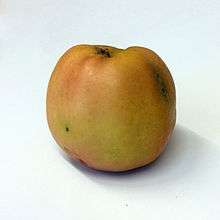 |
Sweden | 15th century | Apple is egg-shaped, medium to large in size, sweet and aromatic. Best in November, keeps well till February. Oldest cultivar in Northern Europe, grown mostly in Sweden and Estonia. | Eating |
| Alkmene agm[2] | |
Germany | 1930 | Cox's Orange Pippin × Doktor Oldenburg | Eating |
| Allington Pippin | |
Lincolnshire, UK | 1880s | A versatile English dessert apple raised by horticulturalist Thomas Laxton some time before 1884. Exhibited as Brown's South Lincoln Beauty, the name was changed to Allington Pippin by Bunyard Nursury in 1896. A cross of Cox's Orange Pippin and King of the Pippins. A small apple, aromatic, with a pineapple-like flavour, keeps its shape when cooked. | Eating, Cooking, Dessert |
| Ambrosia | 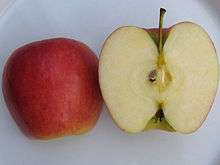 |
British Columbia, Canada | 1980s | Medium to large in size, mostly red coloration with yellow patches. Has cream-coloured flesh with a sweet, crisp, aromatic flavour and low acidity. Ambrosia trees are hardy and no major disadvantages have yet been identified. | Eating |
| Anna | 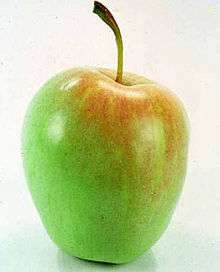 |
Israel | 1965 | Colour is yellow with a red blush. This variety does not grow well in the cold and prefers heat and humidity. | Eating |
| Annurca | Campania, Italy | 1876 (documented) | Very old apple; possibly one of the oldest of all. Believed to be older than first mention in Pasquale's Manuale di Arboricultura, 1876. | Eating | |
| Antonovka |  |
Kursk, Russia | 17th century | A very old Russian variety, often planted at dachas. Apples are large, yellow-green and bracingly tart to eat out of hand, but superb for cooking, as they keep their shape. Extremely tolerant of cold weather, and because it produces a single, deep taproot (unusual among apple trees), Antonovka is propagated for use as a rootstock. Antonovka rootstock provides a cold-hardy (to −45 °C), well-anchored, vigorous, standard-sized tree. | Cooking, Cider |
| Apollo | Cox's Orange Pippin × Geheimrat Dr. Oldenburg | Eating | |||
| Ariane | 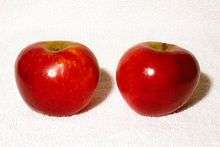 |
Angers, France | 2002 | Scab resistant. Developed at the National Institute of Agricultural Research in France. | Eating |
| Arkansas Black |  |
Arkansas, US | c. 1870 | Hard and crunchy; stores well. Very deep red, appearing black from a distance. | Eating |
| Arthur Turner agm[3] | England | large golden cooker: prone to mildew but scab resistant | Cooking | ||
| Ashmead's Kernel agm[4] | |
England | c. 1700 | Small, very sweet and very tart. | Eating |
| Aurora Golden Gala | British Columbia, Canada | 2003 | Dessert apple; medium size, sweet, juicy, crisp, firm, very long storage life. | Eating | |
| Autumn Glory[5] | Washington, US | 2011 | The Autumn Glory variety is a hybrid of the Fuji (apple) and the Golden Delicious apple, featuring a red over golden background. Very sweet, firm flesh with a subtle "cinnamon" flavour. Produced only by Domex Superfresh Growers in Washington's Yakima Valley. | Eating | |
| Bailey | New York | c. 1840 | Red apple with considerable white flecks. Has some russeting. | Eating | |
| Baldwin | .jpg) |
Massachusetts, US | c. 1740 | Sweet to subacid flavour. Also known as "Woodpecker". Very old variety for North America. Makes lots of juice. | Cooking, Eating |
| Ballyfatten | County Tyrone, Northern Ireland | c. 1740 | A large, round apple with firm, dry, sweet, slightly tart white flesh. Excellent keeper. Scab and canker resistant. | Cooking, Eating | |
| Bardsey Island Apple |  |
Bardsey Island, Wales | 1998 | A medium-sized eating apple with a unique lemon aroma. Sweet and juicy. Skin color red over gold. Very disease resistant. Single tree discovered on Bardsey island in 1998, age of original tree unknown. May have monastic origins. | Eating |
| Beacon | Minnesota, US | 1936 | Lively, juicy flavour; good for baking. Does not keep very well. | Cooking, Eating | |
| Beauty of Bath | 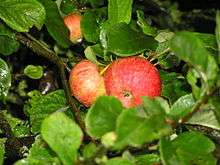 |
England | 1864 | Deep red flush and streaks of red with a little russet. Early maturing but short season. Formerly grown commercially in England for local markets. Good flavour in its home climate if it is eaten soon after picking. Poor flavour if distributed long distances and stored for weeks, so now rare. | Eating |
| Belle de Boskoop agm[6] |  |
Boskoop, Netherlands | 1856 | Bright red, fairly large, early in season (end of August to early September). | Cooking (applesauce) |
| Ben Davis | Southeastern US | Noted for keeping well prior to refrigerated storage, but flavour has been compared with cork. | Eating | ||
| Beverly Hills | California, US | 1997 | Slightly tart flavour. Likes warm weather. | Eating | |
| Birgit Bonnier |  |
Sweden | A cross between Cortland (apple) and Lord Lambourne. | ||
| Bismarck | .jpg) |
Victoria, Australia | 1870 | Medium-sized fruit with a green and red skin, sharp in flavour and not a common apple. | Cooking |
| Blenheim Orange agm[7] |  |
England | c. 1740 | Has greenish-yellow to orange skin streaked with red. Distinctive nutty flavour excellent for cooking. The vigorous tree is slow to come into crop but then produces heavily. | Cooking, Eating |
| Bloody Ploughman | Carse of Gowrie, Scotland | c. 1800 | A medium-sized, very dark red, heavily ribbed apple. Crisp, mildly sweet white flesh, sometimes pink-streaked. It is reputed to have got its name from a ploughman who was caught stealing apples near Megginch Castle and was shot by the gamekeeper. His wife got the bag of apples and threw them on the compost heap where a seedling then grew and - voila - Bloody Ploughman. | Eating | |
| Bottle Greening | Green Mountains, US | c. 1800 | Produces large fruit. Has thick skin, but juicy. | Eating, Cider | |
| Braeburn |  |
New Zealand | 1952 | Chance seedling. The fruit is widely sold commercially in the UK. | Eating |
| Bramley (Bramley's Seedling) agm[8] |  |
Nottinghamshire, UK | 1809 | The fruit is the most widely sold cooker in the UK. Large sized fruits with waxy skin, green with a red flush. A favourite ingredient in many traditional British puddings.[9] | Cooking |
| Bravo de Esmolfe | Esmolfe, Penacova, Portugal | 18th century | A small, juicy and sweet apple, considered one of the best Portuguese apples | Eating | |
| Breedon Pippin | England | 1801 | Sweet flavour. Originally raised by a parson in Berkshire. Rare. | Eating | |
| Brina | Italy | 1998 | Resistant to scab. Spreading habit with intermediate vigour; full flowering season is medium-late, production is heavy, fruit is medium or medium-large, with smooth skin; white lenticels, no russet, excellent taste characteristics. Ripens first week of October (Trentino). | Eating | |
| Byfleet Seedling | England | ||||
| Calville Blanc d'hiver |  |
France | 1598 | Noted for unusual looks (somewhat lumpy on the side) but excellent reward when tried. Noted for having unusually high vitamin C content. Apple of choice for tarte tatin in France. | Cooking |
| Cameo | 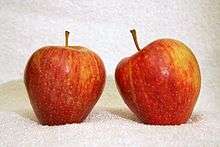 |
Washington State, US | 1980s | Existence owed to freak accidental crossing of two most popular apples in world: Red and Golden Delicious. Retains prongs on bottom of latter parent but has flavour more resembling Golden. | Eating |
| Carolina Red June | Tennessee, US | c. 1810 | Has unusual habit of blossoming twice, and producing two crops per year. Very popular Civil-War-era Southern apple. Does beautifully in humid weather. Good choice for backyard gardener in subtropical climate. | Cooking, Eating | |
| Carroll | 1947 | Ripens early. | Eating | ||
| Carter's Blue | Alabama, US | 1840s | Medium to large, roundish oblate; skin green or greenish yellow washed with dull red with darker red broken tripes, covered with a heavy bluish bloom. Crisp, juicy, sugary, aromatic, mild subacid. Foliage also has a blue hue. Ripens September and keeps until November. Once widely grown in the American South, then thought extinct. Reintroduced to America in 1994 after being discovered at the National Fruit Trust in Kent England, where it had been added in 1947 from a collection in Rhone, France, after it had been acquired around 1860 from the Fruitland Nursery in Augusta, Georgia.[10] | Eating, Cooking | |
| Champion, Shampion or Sampion |  |
Czechoslovakia | c. 1960 | A cross between Golden Delicious and a Cox Orange Pippin. Attractive colour. This tree bears attractive fruit, extra-large sized, deep red, juicy, and crisp. Keeps fresh for a long time. Starts bearing at a young age. Harvest time is October. | Eating, Juice |
| Catshead | England | 1600s | Sharp flavour. Lumpy shape and electric green colouring. Known to have been a variety planted in early Virginia by settlers as well as native England. Extremely rare in native UK; occasionally still found growing in southern US. | Cooking | |
| Charles Ross | Berkshire, UK | 1890s | Has been an AGM winner. Orange to red. Best cooked early in season. Good flavour, and sweet when eaten later in season. | Multi-purpose | |
| Chelmsford Wonder | Essex, UK | c. 1870 | A large long keeping yellow-skinned apple with diffuse orange pink flush. [1]. Still grown in Essex orchards including Lathcoats Farm Shop. | Multi-purpose | |
| Chiver's Delight | Histon, Cambridgeshire, UK | 1920s | Medium to large oblate apple. Red flush over greenish yellow skin. Crisp, juicy, sweet white flesh. Flavour can be variable but at its best is very well balanced. Grown by Chivers (now a brand of Premier Foods) for apple sauce. | Multi-purpose | |
| Claygate Pearmain agm[11] |  |
UK | Suitable for northerly, cold, wet climates: rich, nutty flavour | Dessert | |
| Clivia | Germany | Geheimrat Dr. Oldenburg × Cox's Orange Pippin | Eating | ||
| Cornish Gilliflower |  |
Cornwall, UK | 1813 | Discovered as accidental seedling. Shy bearer. | Eating |
| Cortland |  |
New York | 1890s | Pale crisp flesh. Ripens in October in state of origin. Classic red coloration, nice crunch. | Eating |
| Court Pendu Plat | 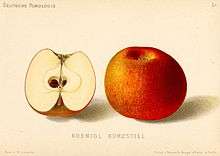 |
France | 1613 | Extremely old variety, may date from as early as Roman times. Popular during the Victorian era. Yellow to light green, flushed with red. | Eating |
| Cox's Orange Pippin | |
England | 1829 | One of the most celebrated apples in the UK, valued for its aromatic "orange" colour and flavour. The fruit is widely sold commercially. Mainly grown in UK, Belgium and the Netherlands but also grown for export in New Zealand. | Eating |
| Cripps Pink ('Pink Lady') | |
Australia | 1970s | Crisp, very sweet and slightly tart. Light red, pink and light yellow-green striped skin. | Cooking, Eating |
| Crispin | 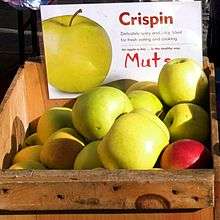 |
Japan | 1930 | See Mutsu | Eating |
| Crimson Delight | Washington | Crimson Delight is a multi-purpose apple intended for snacking, baking and fresh recipes. The fruit size is medium to large with a firm texture and is crisp and juicy. | Eating, Baking etc. | ||
| Crimson Gold | California | 1944 | A golf ball sized applecrab hybrid developed by Albert Etter who named it Little Rosybloom for its cute size and attractive ruby red flush. He died before completing the patent papers. Fruit was later rediscovered and renamed. Very crispy and keeps texture in backing. | Eating, Baking etc. | |
| Criterion | New York | 1898 | One of parents believed to be Ben Davis, but very tart unlike parent. Dark red skin underlaid with stripes. | Cooking, Eating | |
| D'Arcy Spice | Tolleshunt D'Arcy, Essex, UK | 1785 | A medium-sized apple with yellow-green skin, a red blush where exposed to the sun and covered with an spotty ochre russet. White flesh is aromatic, firm and crisp with noticeable hints of anise and clove. | Eating | |
| Delblush |  |
France | 1979 | Tentation delblush , Golden Delicious × Grifer |
Eating |
| Delcorf agm[12] | |
France | 1960 | Delbarestivale delcorf, Golden Delicious × Stark Jonagrimes |
Eating |
| Delfloga | France | 2008 | Delbardivine delfloga, Royal Gala Tenroy × Florina, scab resistant |
Eating | |
| Delflopion | Delbard, France | Sampion × Florina, scab resistant | Eating | ||
| Delrouval |  |
France | 1995 | Cybèle delrouval, Delcorf × Akane |
Eating |
| Deltana | France | 2010 | Delbard Celeste deltana, (Golden Delicious × Grive Rouge) × Florina, scab resistant |
Eating | |
| Devonshire Quarreden | England, France? | 1685 (documented) | Possible French parentage or ancestry. Crimson red peel. Juicy. | Eating | |
| Discovery agm[13] |  |
Essex, UK | 1949 | Possibly from an open-pollinated Worcester Pearmain, or could well be a Worcester × Beauty of Bath. Sharp, sweet flavour. Fruits are sold commercially in the UK. | Eating |
| Dorsett Golden | 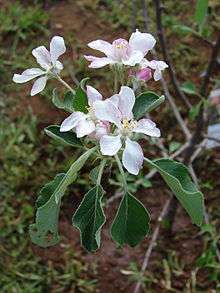 |
Bahamas | 1964 | Grown from chance seedling of Golden Delicious. One of the most southerly apples grown in North America. | Eating |
| Dougherty/Red Dougherty | Australia, New Zealand | Red Doughtery is a recent mutation discovered in New Zealand from the old Australian Doughtery | Eating | ||
| Duchess of Oldenburg |  |
Russia | 18th century | Has red stripes with splashes of green. Excellent resistance to freezing temperatures. | Cooking, Eating |
| Dudley Winter | Castle Hill, Maine, US | 19th century | A medium-sized oblate apple with greenish-yellow skin covered with red stripes over a solid red blush. Flesh is firm but tender, juicy, aromatic and quite tart, becoming milder as it ages. Good for fresh eating and cooking; rated by many as one of the best for apple pies and sauces. Tree is a natural semi-dwarf, very hardy and bears heavily annually. | Cooking, Eating | |
| Dummellor's Seedling agm[14] also known as Dumelow's Seedling[15] | Shackerstone, Leicestershire, UK | 18th century | Large, roundish-oblate apple with pale greenish-yellow skin strewn with large russet dots, occasionally covered with a delicate pinkish-orange blush. Yellow-tinted white flesh is aromatic, firm, crisp, tart, and very juicy. One of the most widely grown culinary apples of Victorian England, esteemed for its fine flavour and good keeping qualities. | Cooking | |
| Egle | Lithuania | Eating | |||
| Early Victoria | Essex, UK | 1899 (introduced) | Possibly from Lord Grosvenor × Keswick Cod. Also called Emmeth Early. Ripens in late July. Pale yellow fruit. | Eating | |
| Edward VII agm[16] |  |
Worcestershire, UK | 1908 (introduced) | A large oblate-round apple with yellow-green skin and pinkish-brown blush. Suitable for more northerly, cold, wet climates. White flesh is sharp and pleasant. Extraordinary keeper; apple ripens in autumn and will keep until Easter. Possibly Blenheim Orange × Golden Noble. | Cooking |
| Egremont Russet agm[17] | 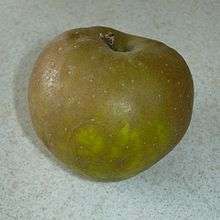 |
Sussex, UK | 1872 | Brown russeting, nutty flavour. Excellent keeper. | Eating |
| Ein Shemer | Israel | 1963 | Zabidani × Golden Delicious. This variety ripens in June. Tastes tart, does not do well in cold weather. (Not the same as Anna (apple)) | Eating | |
| Ellison's Orange agm[18] |  |
Lincolnshire, UK | 1911 | Cox's Orange Pippin × Calville Blanc. Rich aniseed flavour. | Eating |
| Elstar agm[19] |  |
Netherlands | 1950s | Golden Delicious × Ingrid Marie. Medium-sized, mostly red with yellow showing. Often used in desserts due to its intense honey flavour. | Cooking, Eating |
| Emneth Early agm[20] | UK | Suitable for northerly, cold, wet climates. A biennial crop that needs thinning. | Cooking | ||
| Empire | 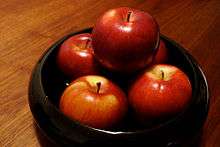 |
New York | 1966 | Lovely white subacid flesh. Tangy taste. Ruby red colour. | Eating |
| Enterprise | Illinois, US | 1993 | Classic North American red apple. Stores well up to six months. Makes very good candy apple. | Eating | |
| Envy |  |
New Zealand | 2009 | Sweet and crispy, takes 4–8 hours after cutting to start browning. Royal Gala × Braeburn. | Eating |
| Epicure | UK | 1909 | Yellowish apple with reddish blush. Good clean taste. | Eating | |
| Esopus Spitzenburg |  |
Esopus, New York | c. 1750 | Grown by Thomas Jefferson at Monticello. Named for creek near which first seedling found. Heirloom variety still available at farmstands in Northeast and portions of Virginia. Difficult to grow for inexperienced planters. | Cooking, Eating |
| Flamenco | UK | 1950–1999 | A columnar ornamental tree with delicious fruit | Eating | |
| Falstaff agm[21] | UK | A good pollinator. | Dessert | ||
| Fiesta agm[22] | |
Kent, UK | 1972 | Sometimes called Red Pippin. Claims both UK and US heritage: parents are Cox's Orange and Idared. Has flavour similar to the former but storage, colouring, and cold tolerance of the latter. | Eating |
| Fireside | Minnesota, United States | 1943 | Very fragrant. Yellow with red striping. Sweet apple, very popular in upper Midwest. | Eating | |
| Florina |  |
Anger, France | (Querina), scab resistant | Eating | |
| Flower of Kent | Kent, UK | 18th century | This is the variety that inspired Sir Isaac Newton to consider gravity. | Eating | |
| Fortune agm[23] (Laxton's Fortune) | 1904 | Cox's Orange Pippin × Wealthy | Eating | ||
| Fuji |  |
Japan | 1930s | Red Delicious × Ralls Genet. Dark red, conic apple. Sweet, crisp, dense flesh is very mildly flavoured. Keeps very well. One of the most widely grown apple varieties in the world. | Eating |
| Gala, Royal Gala agm[24] | 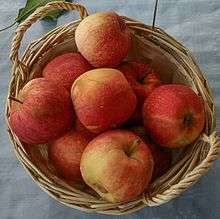 |
New Zealand | 1970s | A small to medium-sized conic apple. Thin, tannic skin is yellow-green with a red blush overlaid with reddish-orange streaks. Flesh is yellowish-white, crisp and grainy with a mild flavour. Cross of three of the world's best known apples: Kidd's Orange Red (a cross of Red Delicious and Cox's Orange Pippin) × Golden Delicious. One of the most widely available commercial fruit. | Eating |
| Garden Royal |  |
Sudbury, Massachusetts, US | 1800s | A medium-sized roundish-oblate, sometimes slightly conical apple. Greenish-yellow skin is striped and splashed with bright red, dull or grayish toward the stem; dots few, light and gray; cavity deep, basin shallow, slightly uneven. Flesh yellow, very tender, juicy, rich, mildly subacid and aromatic. Poor keeper. Upright habit, productive bearer, some biennial tendency. | Eating |
| Gascoyne's Scarlet |  |
Kent, England | 1871 | large red fruit | Eating |
| Geheimrat Dr. Oldenburg |  |
Germany | 1897 | Created at the Höheren Lehranstalt für Obstbau of Geisenheim in the Rheingau; Minister von Hammerstein × Baumanns Renette. | Eating |
| George Cave | Essex, UK | 1923 | Pale green-yellow fruit with red flush. Early harvest. | Eating | |
| George Neal agm[25] | Kent, UK | 1904 | Pale green to yellow colour, will keep nicely until late autumn. | Cooking | |
| Glockenapfel |  |
Switzerland | 17th century | A medium-sized green-yellow elongate bell-shaped apple, sometimes takes on a reddish blush. Tart and juicy, stores well, taste improves with age. Excellent culinary variety; renowned for its use in Strudel. | Cooking, Eating |
| Gloster (aka Gloster 69) |  |
Germany | 1969 | Conical shape. Somewhat tart, ruby red colour like parent Red Delicious. Good choice for backyard gardening. | Eating |
| Ginger Gold |  |
Virginia, US | 1960s | Tangy flavour, crunchy texture, pale green-yellow colour. Noted for being an extremely early bearer (Europe by September 1, California late July, Eastern US in August). | Cooking, Eating |
| Golden Delicious agm[26] | 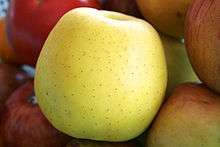 |
Clay County, West Virginia, US | 1914 | One of the most popular varieties in the world. Due to its regular size, even colour and storage qualities the fruit is widely sold commercially. Uniform light green-yellow coloration, very sweet. A good pollinator. | Eating |
| Golden Noble agm[27] |  |
England | 1820 | Tree is short and stocky. Produces mint green fruit with blush of pink. | Eating |
| Golden Orange | Italy | 1979 released 1996 |
PRI 1956-6 × Ed Gould Golden. Resistant to scab. Moderate vigour, spreading habit and medium-late blooming season; fruit is moderately large (207 g) and symmetric, skin is smooth, no russeting. Ripens some days after Golden Delicious; fruit is very attractive; large, good storage ability. | Eating | |
| Golden Russet |  |
New York | 1845 (documented) | A medium-sized heavily russeted light green apple, occasionally with a reddish blush. Crisp, fine-grained flesh is rich, sugary and very sweet. Excellent dessert apple, keeps very well. Makes extraordinary cider, known as the "Champagne of cider apples." | Cider, Eating |
| Golden Spire | Lancashire, UK | 1850 | An old Northern English variety. Unusually tall and oblong with a tart flavour. | Cider, Eating | |
| Golden Supreme | Idaho, US | 1960 | Eating | ||
| Goldspur |  |
Eating | |||
| Gordon | Whittier, California, USA | 1977 | A low chill hour cultivar developed by Robert B. Gordon in Whittier, CA from unknown parentage. Blooms over long period in Southern CA - from April to Early June. Bears mature fruit from August to October. Fruit is green with red striped overcolor. Ripe at approximately 50% red coverage. Fruit is dual purpose, for eating and baking with sweet-tart flavor. | Eating & Cooking | |
| Gradirose | Languedoc-Roussillon, France | 2004 | Created by Pépinières Grard. Early dessert apple with pink blush. Ripens in September and stores well. Very productive. | Eating | |
| Gragg (aka Red Gragg, Winter Queen) | North Carolina, US | 1860 | Originated on the farm of James Gragg in Caldwell County, NC about 1860. Valued by North Carolina growers for its fine cooking qualities, crispness and long storage ability. The conical shaped fruit is red in colour with moderately conspicuous dots. Ripens in October and is a great keeper. | Cooking, Eating | |
| Granny Smith | 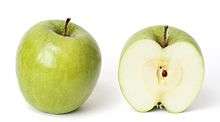 |
Australia | 1868 | This is the apple once used to represent Apple Records. A favourite variety, widely sold in the UK. Also noted as common pie apple. Lime green colouring. Extremely tart. | Cooking, Eating |
| Gravenstein | |
Gråsten, Jutland, Denmark | 17th century | A medium-sized early yellow-green apple, often with red stripes. Crisp, sweet, tart flavour. Exceptional cooking apple, especially for applesauce and pies. Poor keeper; becomes soft quickly. German immigrants introduced this variety to California's San Joaquin Valley in the mid-19th century. Has many sports. | Cooking, Eating |
| Green Cheese | North Carolina or Georgia, US | 18th century | A very old southern apple thought to have originated in North Carolina or Georgia but its true origin is uncertain. The fruit is medium to large, oblate to oblique in shape. The skin is deep green in colour, turning pale yellow when fully ripe. The yellowish flesh is sweet, crisp, tender and juicy. | Eating | |
| Greensleeves agm[28] | Kent, UK | 1966 | Golden Delicious × James Grieve; good garden apple, with a pleasant but unexceptional flavour. Likely named for famous Renaissance era song. | Eating | |
| Grenadier agm[29] | England | 1862 (documented) | Possibly one of the strangest of all British apples: it is ribbed and lumpy with a tough coat, looking as though it has taken a beating. Grenadier cooks down to cream-coloured puree with a superb apple flavour. Makes an excellent apple jam. Poor keeper. Reliably heavy annual bearer. | Cooking | |
| Grimes Golden |  |
Brooke County, West Virginia, US | 1804 | A medium-sized roundish to slightly oblong apple. Greenish-yellow skin, ripening to a clear yellow, stem cavity sometimes russeted, covered with yellow or russet dots. The yellowish-white flesh is crisp and tender, with a rich, spicy, sugary-sweet flavour. A good all-purpose dessert and cooking apple, Grimes also makes a strong single-variety cider. Excellent keeper. Grimes Golden is the parent of the ubiquitous Golden Delicious. Relatively rare among apples, Grimes Golden is self-fertile. Original tree discovered near a known orchard of John Chapman (Johnny Appleseed). | Cider, Cooking, Eating |
| Haralson | Minnesota, US | 1923 | Red colour and large, moderately conspicuous dots. Crisp and juicy with a tart flavour. Excellent choice for pies. | Cooking, Eating | |
| Harrison Cider Apple | New Jersey, US | 1770 | Yellow skin, sometimes red-blush, black spots, small size, sweet, rich and dry. | Cooking, Cider | |
| Hawaii | 1945 (introduced) | Noted for pineapple-like taste. | Eating | ||
| Herefordshire Russet | Kent, England | 2002 | Cox's Orange Pippin x Idared. Rich, aromatic flavour. Pick early October, stores until January. Crops well. | Eating. | |
| Heyer 12 | Very cold-tolerant. | Eating | |||
| Honeycrisp |  |
Minnesota, US | 1960 | Has excellent eating and keeping qualities. Mottled red and yellow colour. Very crisp white flesh is slightly tart with a strong honey-like sweetness. Quality varies from apple to apple. Developed by the University of Minnesota and best suited to cool climates. | Eating |
| Honeygold | Minnesota, US | 1969 | Sweet tasting fruit. Tree has very showy, light pink blossoms in spring. | Eating | |
| Howgate Wonder | Isle of Wight, UK | 1960 | Usually a big apple. Makes a lot of juice. | Cooking | |
| Idared agm[30] | 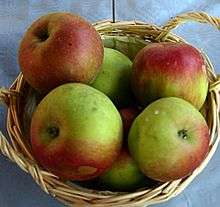 |
Moscow, Idaho, US | 1942 | A medium-sized deep red apple. Crisp white flesh is tart and juicy, and can be somewhat bland if eaten out of hand, however, Idared is an exceptional cooking apple. Flesh keeps is shape, and the flavour becomes much stronger with cooking. An excellent keeping apple, Idared remains hardy and durable in proper storage for as long as 8 months. Idared is a cross between Jonathan and Wagener developed at the University of Idaho. | Cooking |
| Irish Peach | Kilkenny, Ireland | 19th century | Excellent for baking. Early harvest. More difficult to find within land of origin due to primary use for export to UK. Hardy, tastes very good straight off tree. | Cooking, Eating | |
| James Grieve agm[31] |  |
Edinburgh, Scotland | 1893 | Good taste, but poor keeper (bruises easily). | Cooking, Eating |
| Jazz (Scifresh) | 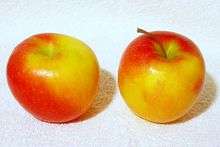 |
New Zealand | 2007 (launched) | Bright red round apple with subtle yellow under-striping. Tart to sweet, dense and very crunchy with effervescent texture. From sweet Royal Gala × firm, tart Braeburn. Widely sold commercially in the UK. | Eating |
| Jonagold agm[32] |  |
New York | 1968 | Popular in Europe and land of origin. Several highly coloured strains are available. Widely sold commercially in the UK. | Eating, Cooking |
| Jonathan |  |
New York | 1820s | Tart taste. Mostly red apple with patches of lime green. Does well in cooler areas; some frost resistance. | Cooking (Pie), Eating |
| Junaluska | North Carolina, US | c. 1815 | Battle of Horseshoe Bend, believed to have planted original tree. Extremely russeted and ugly apple but very hardy tree with superior taste to commercial varieties. | Cooking, Cider, Eating | |
| Junami |  |
Switzerland | c. 2010 | A cross between Ideared and Maigold with Elstar. Beautifully round, fresh and fruity taste with a crunchy bite. | Cooking, Eating |
| Jupiter agm[33] | 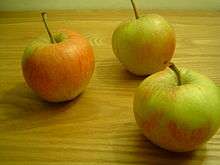 |
North Carolina, US | c. 1815 | A large, round, slightly conic apple. Light yellow-green skin with a red-orange blush and stripes. Strong apple flavour is well-balanced between sweet and sharp. Cross of Cox's Orange Pippin and Starking Delicious (a sport of Red Delicious), apple retains Cox's flavour, but tree is easier to grow. | Eating |
| Kalmar Glasäpple | 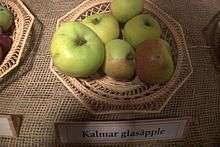 |
Sweden | 18th century[34] | The body is light yellow, and the taste is a mix of acidity and sweetness. Harvesting may begin in early October and it is typically fully ripe in early December. | Cooking, Eating |
| Kanzi (Nicoter) | 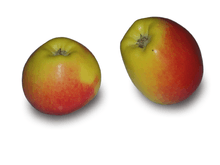 |
Belgium | 1991 | Gala × Braeburn. Crunchy, juicy, sweet, slightly tangier than Gala. | Eating |
| Karmijn de Sonnaville | |
Wageningen, Netherlands | 1949 | Yellow ground colour when ripe, with red flush, and russet depending on the season. Large apple, though shape can be irregular. | Cooking (Apple Juice), Eating |
| Katy | Sweden | 1947 | Medium-sized early eating apple with red skin and pale cream flesh. Well suited to Northern European climate. | Eating | |
| Kerry Pippin | County Antrim, Ireland | c. 1805 | Pale to golden yellow flesh. Delightful spicy taste. Well suited to Ireland's moist, cool climate. | Eating | |
| Kidd's Orange Red agm[35] | New Zealand | 1924 | Cox's Orange Pippin × Delicious. Yellow skin with orange red flush. Chewy rather than crunchy. | Eating | |
| King | 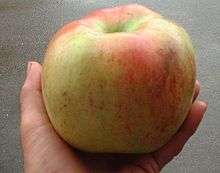 |
United States | Eating | ||
| King of the Pippins agm[36] | UK | Suitable for more northerly (southerly in the Southern Hemisphere) areas with higher rainfall | Eating, cooking | ||
| King Russet agm[37] | UK | Russetted form of 'King of the Pippins' | Eating | ||
| Knobbed Russet | Sussex, England | 1819 | Green and yellow, with rough and black russet. Unusually irregular, warty and knobbly surface. | Cider, Eating | |
| Kosztela | Poland | 16th century | Eating | ||
| Lady Alice | Washington, US | 1979 | Medium-sized, roundish oblate with thin yellow-green skin with an orange blush and bright red stripes. Crisp yellowish-white flesh is sweet with hints of honey and almond. Don Emmons purchased a neglected orchard of Red Delicious near Gleed, Washington, in 1978. While cultivating between trees, a disc from the plow hit the base of a tree. The injury caused a new shoot to grow from the rootstock (likely a seedling grown from a pip). The shoot was allowed to grow and bear fruit which Mr. Emmons named for his mother, Alice.[38] | ||
| Lane's Prince Albert agm[39] |  |
England | 1841 | Green with orange blush. Makes a good apple crumble for Christmas: peak ripening happens in winter. | Cooking |
| Laxton's Epicure agm[40] | UK | Aromatic sweet fruit, tendency to biennial habit, bruises easily. | |||
| Laxton's Fortune See 'Fortune' | |||||
| Laxton's Superb | England | 1897 | Wyken Pippin × Cox's Orange Pippin. Classic old Victorian, British apple. Green with dull red flush. Firm texture, but not very good juice producer. | Eating | |
| Liberty | New York | 1978 | Very disease-resistant. Very similar appearance to McIntosh, relatively short storage life in air. | Eating | |
| Limelight | Kent, England | 2000 | Greensleeves type; abundant cropping and a compact tree. A pale green apple with a smooth finish and occasional pink blush. Crisp flesh and disease resistant tree. | Eating | |
| Liveland Raspberry apple | Livland Governorate | Old | Eating | ||
| Lodi | Ohio, US | 1911 | Fruit pale yellow flushed with deeper yellow. Resistant to scab. Tangy taste. | Eating | |
| Lord Derby | Cheshire, England | c. 1850 | Yellowish green apple. Acid flavour, likes cooler weather. | Cooking | |
| Lord Lambourne agm[41] |  |
England | 1921 | James Grieve apple × Worcester Pearmain. Round shape. Orange flush with hint of russet. Strong acid flavour. Good for domestic cultivation. | Eating |
| Macoun |  |
New York | 1923 | Cold-tolerant. Crunchy. Does very well in salads. | Eating |
| Maiden's Blush | Burlington, New Jersey, US | 19th century | A thin-skinned, flattened apple. Pale yellow-green skin has a telltale crimson blush on the side that faced the sun. White flesh is crisp with a sharp flavour that mellows with storage. Heavy annual bearer. Good cooker. Excellent variety for drying because the flesh remains white and bright. | Cooking, Eating | |
| Malinda | Vermont, US | 1860 | Small, conical with sheep's nose; deep, rich yellow with red spots possible. Dry, dense, substantive flesh; mild, pear-like flavour. Tree good in climates with heavy snowfall. | Cooking, Eating | |
| Mantet |  |
Manitoba, Canada | 1929 (introduced) | Amber fruit washed with red. Summer apple. Does not do well in warm climates. | Eating |
| Manks Codlin | |
Isle of Man | 1815 (First fruited) | Pale yellow medium-sized fruit with occasional flush of red. Hardy. Heavy producing. | Cooking |
| Margil | London | 1750s | Small, highly flavoured apple held in very high esteem by connoisseurs. Medium to small in size, slightly conical in shape, dull green skin with an orange-red blush, some russeting. The yellow flesh is firm, crisp, sugary, and as pomologist Robert Hogg said, "with a powerful and delicious aromatic flavour." The very small tree is weak and slender and bears light crops. Because it flowers early, it is susceptible to frost damage. It keeps well. Introduced to Brompton Park Nursury from Versailles by Henry Wise in the early 18th century. | Eating | |
| May Queen | .jpg) |
Worcester, England | 1800s | Large, oblate, often russetted yellow apple with bright red blush and stripes. Crisp, greenish-yellow flesh, rich, nutty flavour. Similar texture to Ribston Pippin, and in a good year, its equal in flavour. In bad years it can be rather dry and harsh. Excellent keeper. Heavy annual bearer. | Eating |
| McIntosh | 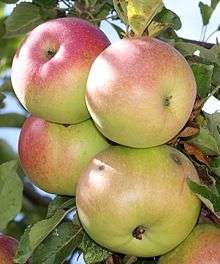 |
Ontario, Canada | 1811 | A popular, cold-tolerant eating apple in North America. | Cooking (applesauce), Eating, Pies |
| Melba |  |
Ontario | Eating | ||
| Melon | .jpg) |
Connecticut | 1800 | Eating | |
| Melrose | 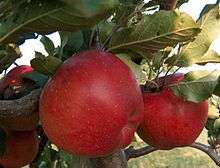 |
Ohio, US | 1944 | Flavour improves in storage. Coarse flesh. | Eating |
| Merton Charm agm | UK | Semi-weeping habit, heavy crops of small fruit unless thinned | |||
| Merton Worcester | England | 1956 | Cox's Orange Pippin × Worcester Pearmain. Developed at John Innes Institute. | Eating | |
| Miller's Seedling | Berkshire, England | 1848 | Sweet apple. Tree prefers chalky soils. | Eating | |
| Mollie's Delicious | New Jersey, US | 1966 | Conical shape, pinkish red colour. Lasts long in refrigeration. Good aftertaste. | Eating | |
| Mother (American Mother) | Massachusetts, US | 1840 | Medium-sized yellow apple with crimson stripes and darker red blush. White flesh is rich, sweet and juicy. The fruit has a balsamic aroma with a suggestion of vanilla. Cropping can be a bit irregular, if not completely biennial. A late flowering variety that avoids frost. Some resistance to scab. | Eating | |
| Muscadet de Dieppe | Normandy, France | c. 1750 | Commonly used in making Calvados brandy. | Cider | |
| Mutsu |  |
Aomori Prefecture, Japan | 1930 | Known as "Crispin" in the UK. Golden Delicious × Indo. | Eating |
| My Jewel | Watsonville, California | c. 1940[42] | Originated as a chance seedling, a cross between Winter Banana and Golden Delicious.[43] Yellow colour. October harvest. Still used in cider blends by Martinelli's)[44] | Eating, Cooking, Cider | |
| Newell-Kimzey ( Airlie Red Flesh) | Airlie, Oregon | 1961 | A medium to medium -large, conic apple. Light yellow-green skin with white dots, occasionally with red-orange blush on one side.Light pink to deep red flesh is crisp, sweet and moderately tart. | Eating, pies | |
| Newtown Pippin (Albemarle Pippin) | .jpg) |
Queens County, New York | 1759 | Best known colonial apple in North America. Known favourite of Ben Franklin and Thomas Jefferson. Medium to large, often irregularly shaped apple. Greenish-yellow, dotted, often russeted. Tough skin, flesh cream to greenish-white, very quickly browning. Texture is crisp, moderately fine-grained subacid to tart, sprightly. Biennial habit, slow to come into bearing. Good keeper, improves with storage. Prized for its clear juice in cider making. Two sports, Green Newtown Pippin and Yellow Newtown Pippin, differ only in skin colour. | Cooking, Eating, Cider |
| Newton Wonder agm[45] | Melbourne, Derbyshire, England | 1870s | Very good cooker. Prolific bearer, can be harvested in winter. Keeps well until March. | Cooking | |
| Nickajack | North Carolina, United States | c. 1810 | Native American origin, believed to be originally grown by Cherokee along banks of Nickajack Creek. Only grown in Appalachians, favourite of later settlers for desserts. Rusty red colour with sweet, crisp taste. | Cooking, Eating | |
| Norfolk Royal | England | c. 1850 | Crisp, sharply sweet and well-flavoured. Available as a russet or smooth. | Eating | |
| Northern Spy |  |
New York | c. 1800 | Tart, firm, stores very well. Noted for being excellent choice for making American-style apple pie. Sometimes used as a rootstock. | Cider, Cooking, Eating |
| Opal | Czech Republic | 1999 | Firm, fine to medium grained, medium juicy, full flavoured, sweet, mild-subacid. Golden Delicious × Topaz.[46] | Eating | |
| Orin | Japan | 1952 | Sweet and distinctive fragrance. Notes of pineapple. Medium hardness. Golden Delicious × Indo. | Eating | |
| Orleans Reinette |  |
Orleans, France | 1776 | Reliable bearer. Extraordinary complex flavour, similar to Blenheim Orange, but not related. | Eating |
| Ozark Gold | Missouri, US | 1970 | Light green with pink blush. Has taste with notes of honey. | Eating | |
| Pacific Rose |  |
New Zealand | 1995 | Extremely crisp, sweet apple. Also grows well in California. | Eating |
| Pam's Delight | Bedfordshire, England | 1958 | A medium-sized apple with a red blush. Flesh is crisp, juicy and sweet-tasting. Alfred Hull, a retired clerk planted some apple pips in pots which he placed on his bathroom windowsill. He planted the most vigorous in his garden. His daughter, Pam, teased her father by telling him that he should dig the tree up as it did not look as if it was capable of producing fruit. Unfortunately, Pam developed Hodgkin's Disease, and Alfred told her that if his tree, which had become a family joke, ever bore fruit she would be the recipient of the first apple. Seven years after he planted the pip, the tree produced its first blossom, and from that, a single apple. He proudly presented it to Pam that October. Sadly, her illness became more severe, and she died, at the age of 28 the following April, just as the tree blossomed fully for the first time. That year the tree produced twenty two pounds of apples. In 1968, Brogdale Farm accepted Pam's Delight for full commercial trials. Later that year it was included in the National Register.[47] As of 2011, Pam's Delight is available from East of England Apples and Orchard Group. | Eating | |
| Paula Red | 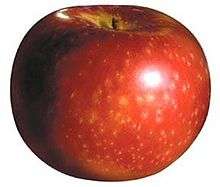 |
Kent County, Michigan, US | 1960s | Firm white flesh; McIntosh mutation. | Eating |
| Peasgood's Nonsuch agm[48] |  |
England | 1858 | A very large yellowish-green apple, deepening to orange-yellow, flushed and striped red with some russet patches. Flesh is sweet and juicy. Good eating and superb for cooking. Large, hardy and heavy cropping tree. Apples can weigh up to half a kilogram, and are famously large enough to make a pie from a single apple. | Cooking, Eating |
| Pink Pearl | .jpg) |
California, US | 1944 | Noted for having bright pink flesh. Sweet. Possibly has crab apple in its ancestry. Makes cider have a reddish tint if pressed. | Eating |
| Pinova |  |
Germany | 1986 | Bred in Germany over an 18-year period. Marketed as "Piñata" in the United States. Fragrant smell, thin skin and balanced sweet and tart flavour profile. From Clivia × Golden Delicious. | Cooking, Eating |
| Pitmaston Pineapple |  |
Moseley, Worcester, England | 1785 | Pitmaston Pineapple is a dessert apple known since 1785. Small oblong apples with a yellow-green russeted skin. Tender flesh is an intense nutty, honeyed flavour with, as the name suggests, tropical undertones and some balancing acidity. Trees are biennial but produce heavy crops in the 'on' year. | |
| Pixie agm[49] | England | 1947 | Resistant to scab and mildew. Very small apple. | Eating | |
| Pristine | 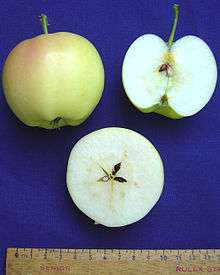 |
USA | Resistant to most diseases | Eating | |
| Prima | USA | 1958 | Resistant to scab and most diseases | Eating | |
| Porter's | US | Smallish, squat, deep golden yellow colour with red blush and firm, white, fine-grained aromatic sweet flesh. | Eating, Cooking or Cider. | ||
| Pott's Seedling | England | Pale green to yellow colour and white flesh. | Cooking | ||
| Pound Sweet | Manchester, Connecticut, US | 1834 | Amber coloration. Used mostly for making apple butter. Russets. Does well in moderate cold. Suitable to areas with snowy winters. | Cooking | |
| Rajka | Czechoslovakia | Scab-resistant cross of Rezista × Rome | Eating | ||
| Red Astrachan |  |
Russia | c. 1800 | Extremely resistant to frost. | Cooking |
| Red Delicious | 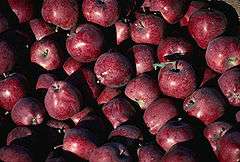 |
Iowa, US | c. 1870 | Unmistakable for its acutely conic shape, dark red colour and telltale bumps on bottom. Flavour is sweet and mild, bordering on bland. Poor choice for cooking or cider. Original seedling known as "Hawkeye." Rights bought by Stark Brothers in 1893. First marketed as "Delicious" or "Stark's Delicious," name changed to "Red Delicious" in 1914 when Stark bought the rights to Mullin's Yellow Seedling, changing that apple's name to "Yellow Delicious". Red Delicious has many sports and ranks as the world's most prolific apple. | Eating |
| Red Prince |  |
Weert, Netherlands | 1994 | Medium-sized, conic, uniform deep red skin. White flesh is crisp, sweet and juicy, with hints of cherry and almond. Excellent keeper. Chance seedling (a natural cross of Jonathan and Golden Delicious) discovered in 1994. Marketed throughout Europe, in 2001, Global Fruit in Ontario became exclusive growers of the variety in North America.[50] | Eating, Cooking |
| Rev. W. Wilks | Slough, Buckinghamshire, England | 1904 | Peasgood's Nonsuch x Ribston Pippin. Pastel green with a light pink flush. Very disease-resistant. Cooks to a light, pale puree, hardly needing any sugar. | Cooking | |
| Rhode Island Greening | 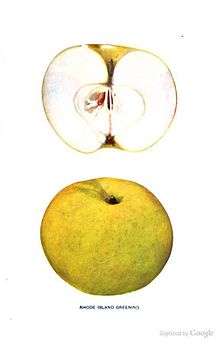 |
Newport, Rhode Island, US | 1650s | Extremely old variety for United States, second only to Roxbury Russet in age. Tartness can make eyes water. Grass-green colour with some possible russeting near stem. Occasional reddish pink blush | Cider, Cooking |
| Ribston Pippin agm[51] |  |
Knaresborough, North Yorkshire, England | 1708 | An irregularly-shaped and sometimes lopsided apple, usually round to conical and flattened at the base with distinct ribbing. Skin is yellow with an orange blush and red streaked with russet dots. Yellow flesh is firm, fine-grained, and sweet with a pear-like flavour. The original Ribston Pippin sprouted in 1708 from one of three apple pips sent from Normandy to Sir Henry Goodricke, 4th Baronet of Ribston Hall at Knaresborough. The original tree stood until 1835. It then sent up a new shoot and, on the original roots, lived until 1928. Ribston Pippin is thought to be a parent of Cox's Orange Pippin. | Eating |
| Rome Beauty |  |
Rome, Ohio, United States | 19th century | Rounded, deep red, and very glossy. Crisp, juicy white flesh is mild as a dessert apple, but develops an extraordinary depth and richness when cooked. Good keeper. | Cooking |
| Rosemary Russet agm[52] | UK | Regular cropper. Fruit sweet and sharp, like 'Ashmead's Kernel'. | |||
| Roxbury Russet | Massachusetts, United States | c. 1640 | First tree a chance seedling grown in Roxbury, Massachusetts, now a neighborhood of Boston. Oldest known variety of apple in America, planted by Pilgrim Fathers as foundation stock for Massachusetts Bay Colony. Knobbly, russetted coat gives green skin a bronze tinge and hides a cream coloured flesh. Excellent keeper; resistant to fireblight. Mild flavour. Multi-purpose apple that is a wonderful choice for pies, eating fresh, or cider. Still available in New England farmer's markets; commercial interest recently renewed in this cultivar because of its past use as a cider apple. | Cooking (pies), Eating, Cider. | |
| Royal Gala See Gala | |||||
| Rozela | Czech Republic | 2008 | Flesh is medium firm, juicy with great aromatic flavour and delicate smell. The skin is attractive bright red with prominent lenticels. Annual producer of heavy crops, the resistant equivalent of Idared with outstanding flavour. | Eating | |
| Rubens (Civni) | 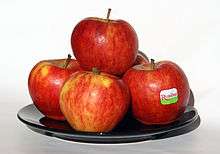 |
Italy | 1985 | Sweet and crunchy; Gala × Elstar. | Eating |
| St. Edmund's Pippin agm[53] | Suffolk, England | 1870s | Unusual in fact that it has scaly russet patches mixed with smooth. Has vanilla/pear taste. Usually a light yellow-green. | Eating | |
| Santana[54] |  |
Wageningen, Netherlands | 1978 | Scab resistant. | Eating. |
| Saturn | Kent, England | 1980 | Scab resistant. | Eating. | |
| Scrumptious | Kent, England | 2003 | Sweet and crisp. Self-fertile, mid-season variety that ripens in early September and will store well for about a month. The blossom is frost hardy resulting in heavy crops and the tree can be grown in all areas of the UK. The flesh is crisp and aromatic and the thin skin turns deep red as it develops | Eating | |
| Sirius | Czech Republic | 2007 | Flesh yellow, firm, crisp, fine
grained, very juicy, well balanced sugar and acid level, rich flavour |
Eating | |
| Smokehouse | Mill Creek, Pennsylvania, US | 1837 | A medium to small apple. Greenish-yellow with flushed red-orange stripes. The yellowish-white flesh is crisp and tender with a spicy-sweet flavour that tastes like cider. Excellent all-purpose apple. Unusual in that it also makes excellent cider. Seedling discovered growing next to the smokehouse on William Gibbons' farm in Mill Creek, PA. Bears fruit from young age. | Eating, Cooking, Cider. | |
| Snow apple (Fameuse) | Quebec, Canada | 17th century | Tender, aromatic, distinct flavour. A parent of McIntosh. | Cider, cooking, eating | |
| Sonya | New Zealand | 2000 | Cross between a Red Delicious and Gala. Coppery coloration. Crisp. | Eating | |
| Ros Picant | Romania | 19th century | Characterized by its distinct, faintly spicy flavor. Green and yellow, mostly used for making cider and Pálinka. | Cider, cooking, Eating | |
| Spartan | 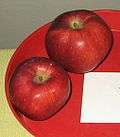 |
British Columbia, Canada | 1926 | Good all-purpose, medium-sized apple. Has a bright red blush and may have background patches of greens and yellows. Popular across border in United States as well. | Cooking, Eating |
| Splendour/Splendor | New Zealand | 1948 | Descendant of Red Dougherty x Golden Delicious, ancestor of Pacific Rose and Aurora Golden Gala | Eating | |
| Star of Devon | UK | 1905 | medium-sized red dessert apple | Eating | |
| Stark Earliest | |
US | 1938 | Does nicely in fruit salads. Red striping on light background. Ripens in summer. | Eating |
| Stayman | US | 1866 | Dullish red skin often covered with a light russet. Tart, wine-like flavour. Stores well. Particularly known for tangy cider. | Cider, Cooking, Eating | |
| Streifling Herbst | Netherlands or Western Europe | Sour sweet. Popular in Eastern Europe | Eating, juice, jam, compote, dried | ||
| Sturmer Pippin | Sturmer, Essex, England | c. 1800 | A medium-sized, bright greenish-yellow apple with a reddish-brown blush, often on one face only. White-fleshed and crisp. One of the best English keeping apples, with proper storage Sturmer Pippin lasts 4 to 5 months. Flavour is sprightly, more sharp than sweet when first picked, but improves dramatically in storage, becoming sweeter and richer, while maintaining its crisp texture. This keeping ability made it ideal for long journeys, as such, it was brought to Australia where it is still widely grown. Parent of Granny Smith. | Eating | |
| Summerfree | Italy | 1998 | Resistant to scab. Spreading habit with moderate vigour, fruit is large, average weight of 175 g, skin is smooth, ripens 1–2 days before Gala, good storage ability. | Eating | |
| Sunset agm[55] |  |
England | 1918 | Easy to grow. Has very similar flavour to Cox's Orange Pippin. Won't do well in heat. | Eating |
| Suntan agm[56] |  |
UK | Fruits ripen orange-red, flavour is sharp and intense | ||
| Sweet Sixteen | Minnesota, US | 1973 | Large fruit, some russeting near top. Moderately acidic taste. | Eating | |
| SweeTango |  |
Minnesota, US | 2009 | Juicy and sweet, and viewed as a successor to the Honeycrisp by many growers. | Eating |
| Teser | USA | 1944 | Resistant to scab. | Eating | |
| Tolman Sweet | US | 1822 | Very sweet apple. Once used to make dried fruit for winter. | Cider, Cooking | |
| Tom Putt |  |
Trent, Dorset, England | 18th century | Small to medium, flat and irregularly shaped apple. Green, usually covered entirely with a bright red blush. Crisp, sharp flavour. An excellent cooker and ideal single-variety cider apple. Softens during storage. Tree is vigorous and precocious. Scab-resistant. Seedling found by a Rev. Tom Putt of Trent, Somerset, England in the late 1700s. Triploid. | Cider, Cooking |
| Topaz | |
Czechoslovakia | 1990 | Rubin × Vanda, scab-resistant, sharp flavour. | Cider, Cooking, Eating |
| Twenty Ounce | New York | 1840 | Huge: apple weighs over one pound, or nearly 500 g. Green overlaid with broad red striping. Excellent cooker. Nice juice qualities. | Cider, Cooking, Eating | |
| Tydeman's Early Worcester | England | 1929 | Mclntosh × Worcester Pearmain. Crimson over yellow background colour. | Eating | |
| Tydeman's Late Orange | England | 1930 | Good storage qualities, but loses fragrance with age. | Eating | |
| Wagener | New York | 1795 | Antique American variety, known since Colonial times. Tree is scab-resistant. Green with red flush, crispy, subacid and sweet. Keeps very well. Very versatile in kitchen; not only does it cook well, but makes a good single-variety cider. Wagener is a parent of Idared, to which it imparts its keeping and cooking qualities. | Cider, Cooking, Eating | |
| Warner's King agm[57] | Kent, England | c. 1700 | Oblong and light green. Very tart. Do not attempt to eat out of hand. | Cooking | |
| Westfield Seek-No-Further | Westfield, Massachusetts, US | 18th century | A medium-sized conic to truncate-conic apple. Greenish-yellow, dull skin, flushed orange with carmine stripes, russet dots and patches. Shaded fruit are often irregularly russeted all over, with little colour showing. Flesh is light buttery-yellow, firm but tender, and moderately fine-grained. Flavour is nicely balanced, a honey-like sweetness balanced with a lemon-like citric acidity, rich, notes of pear and vanilla. Vigorous grower, some disease resistance. | Eating | |
| Wealthy | .jpg) |
Minnesota, US | 1860 | Cherry Red × Sops of Wine.
Pretty reddish pink coat. Believed at one time Minnesota was too cold to grow apples until "Wealthy" was cultivated. Now a parent to many apples for resistance to temperatures below freezing. Still available in upper Midwest. |
Eating |
| White Transparent | 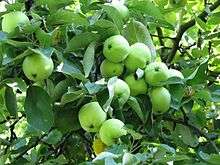 |
Latvia | 1850 | Very pale green skin with an almost white flesh, it is very sharp in taste. Fruit bruises easily and goes soft once harvested. | Cooking |
| Winesap | United States | 1817 | Sweet with tangy finish. Reddish blush flecked with some green. | Cider, Eating | |
| Winston (Winter King) agm[58] | 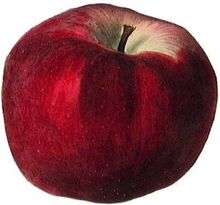 |
England | c. 1935 | Cox Orange × Worcester Pearmain. Originally called Winter King because of its extraordinary keeping ability, renamed during World War II for Winston Churchill. | |
| Wijcik McIntosh | British Columbia, Canada | Mid 1960's | Mutation of McIntosh apple that first showed columnar ornamental properties | Eating, Cooking, Ornamental | |
| Wolf River | .jpg) |
Wisconsin, US | 1881 | Apple very large, some growing to size of large grapefruit. Red with yellow blush. Once very popular commercial apple in United States but presently relegated to upper Midwest if grown for profit. Occasionally can be found growing wild in backcountry thickets or abandoned land in Shenandoah Valley. Named for area where found. Feral trees can be brought back with care and pruning. | Cooking, Eating |
| Worcester Pearmain agm[59] |  |
Worcestershire, England | 1873 | Crisp and sweet strawberry flavour when ripe. Best if eaten early in season (September). | Eating |
| Wyken Pippin | England or Netherlands | Old | Small flattened golden apple with delicious flavor | Eating | |
| York Imperial agm[60] |  |
York, Pennsylvania, US | 1820 | Tart yet sweet, preserves well, lop-sided shape | Cider, Cooking, Eating |
| Zestar | Minnesota, US | 1999 | Red and greenish-yellow, round, sweet and tangy, preserves well | Cooking, Eating |
Cider apples
Cider apples may be far too sour or bitter for fresh eating, but are used for making cider. Some apples (especially older ones from the U.S. and Canada) are used for both cider and eating purposes.

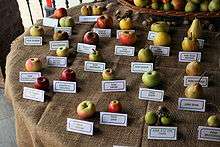

| Common name | Origin | First developed |
|---|---|---|
| Baldwin | Wilmington, Massachusetts, US | c. 1740 |
| Brown Snout | Herefordshire, England | c. 1850 |
| Dabinett | Somerset, England | late 19th century |
| Dymock Red | Gloucestershire, England | |
| Ellis Bitter | Newton St. Cyres, Devon, England | c. 1850 |
| Foxwhelp | Gloucestershire, England | c. 1600 |
| Hagloe Crab | ||
| Hangdown | Somerset | |
| Kingston Black | Near Taunton, Somerset, England | late 19th century |
| Newtown Pippin | Queens County, New York, US | c. 1750 |
| Redstreak | Herefordshire, England | c. 1630 |
| Roxbury Russet | Massachusetts, US | c. 1640s |
| Slack-ma-Girdle | Devon, England | 18th century |
| Stoke Red | Rodney Stoke, Somerset, England | early 20th century |
| Styre | Forest of Dean | before 1600 |
| Tremlett's Bitter | Exe Valley, UK | c. 1820 |
| Vista Bella | Rutgers University, US | 1944 |
| Winesap | US | c. 1817 |
| Woodcock | Gloucestershire | c. 1600 |
| Yeovil Sour | Yeovil, Somerset | c. 1824 |
Rootstock cultivars
Selection of rootstock cultivars can be difficult: vigorous roots tend to give trees that are healthy but grow too tall to be harvested easily without careful pruning, while dwarfing rootstocks result in small trees that are easy to harvest from, but are often shorter-lived and sometimes less healthy. Most modern commercial orchards use one of the "Malling series" (aka 'M' series), introduced or developed by the East Malling Research Station from the early 20th century onward. However, a great deal of work has been done recently introducing new rootstocks in Poland, the U.S. (Geneva), and other nations. The Polish rootstocks are often used where cold hardiness is needed. The Geneva series of rootstocks has been developed to resist important diseases such as fireblight and collar rot, as well as for high fruit productivity.
See also
- Cooking apple
- Lists of cultivars
- List of apple dishes
- Lodi (apple)
- Sandow (apple)
- Welsh Apples
-
 Food portal
Food portal
References
- ↑ Elzebroek, A.T.G.; Wind, K. (2008). Guide to Cultivated Plants. Wallingford: CAB International. p. 27. ISBN 1-84593-356-7.
- ↑ "RHS Plant Selector - Malus domestica 'Alkmene'". Retrieved 23 May 2013.
- ↑ "RHS Plant Selector - Malus domestica 'Arthur Turner'". Retrieved 23 May 2013.
- ↑ "RHS Plant Selector - Malus domestica 'Ashmead's Kernel'". Retrieved 23 May 2013.
- ↑ "Archived copy". Archived from the original on 2013-02-19. Retrieved 2012-12-31.
- ↑ "RHS Plant Selector - Malus domestica 'Belle de Boskoop'". Retrieved 23 May 2013.
- ↑ "RHS Plant Selector - Malus domestica 'Blenhein Orange'". Retrieved 23 May 2013.
- ↑ "RHS Plant Selector - Malus domestica 'Bramley'". Retrieved 23 May 2013.
- ↑ http://www.bbc.co.uk/food/bramley_apple
- ↑ Calhoun, Creighton Lee, Jr. "Old Southern Apples", Blacksburg, Virginia 1995, MacDonald and Woodward, (ISBN 978-0-939923-37-3), page 59
- ↑ "RHS Plant Selector - Malus domestica 'Claygate Pearmain'". Retrieved 23 May 2013.
- ↑ "RHS Plant Selector - Malus domestica 'Delcorf'". Retrieved 23 May 2013.
- ↑ "RHS Plant Selector - Malus domestica 'Discovery'". Retrieved 23 May 2013.
- ↑ "RHS Plant Selector - Malus domestica 'Dummellor's Seedling'". Retrieved 23 May 2013.
- ↑ http://apps.rhs.org.uk/agm/award3.asp?ID=155543
- ↑ "RHS Plant Selector - Malus domestica 'Edward VII'". Retrieved 23 May 2013.
- ↑ "RHS Plant Selector - Malus domestica 'Egremont Russet'". Retrieved 23 May 2013.
- ↑ "RHS Plant Selector - Malus domestica 'Ellison's Orange'". Retrieved 23 May 2013.
- ↑ "RHS Plant Selector - Malus domestica 'Elstar'". Retrieved 23 May 2013.
- ↑ "RHS Plant Selector - Malus domestica 'Emneth Early'". Retrieved 23 May 2013.
- ↑ "RHS Plant Selector - Malus domestica 'Falstaff'". Retrieved 23 May 2013.
- ↑ "RHS Plant Selector - Malus domestica 'Fiesta'". Retrieved 23 May 2013.
- ↑ "RHS Plant Selector - Malus domestica 'Fortune'". Retrieved 23 May 2013.
- ↑ http://apps.rhs.org.uk/plantselector/plant?plantid=4638
- ↑ "RHS Plant Selector - Malus domestica 'George Neal'". Retrieved 23 May 2013.
- ↑ "RHS Plant Selector - Malus domestica 'Golden Delicious'". Retrieved 23 May 2013.
- ↑ "RHS Plant Selector - Malus domestica 'Golden Noble'". Retrieved 23 May 2013.
- ↑ "RHS Plant Selector - Malus domestica 'Greensleeves'". Retrieved 23 May 2013.
- ↑ "RHS Plant Selector - Malus domestica 'Grenadier'". Retrieved 23 May 2013.
- ↑ "RHS Plant Selector - Malus domestica 'Idared'". Retrieved 23 May 2013.
- ↑ "RHS Plant Selector - Malus domestica 'James Grieve'". Retrieved 23 May 2013.
- ↑ "RHS Plant Selector - Malus domestica 'Jonagold'". Retrieved 23 May 2013.
- ↑ "RHS Plant Selector - Malus domestica 'Jupiter'". Retrieved 23 May 2013.
- ↑ Kalmar Glasapple, kalmarlexikon.se, Retrieved 17 January 2016
- ↑ "RHS Plant Selector - Malus domestica 'Kidd's Orange Red'". Retrieved 23 May 2013.
- ↑ "RHS Plant Selector - Malus domestica 'King of the Pippins'". Retrieved 23 May 2013.
- ↑ "RHS Plant Selector - Malus domestica 'King Russet'". Retrieved 23 May 2013.
- ↑ Story of Lady Alice Archived 2012-01-16 at the Wayback Machine.
- ↑ "RHS Plant Selector - Malus domestica 'Lane's Prince Albert'". Retrieved 23 May 2013.
- ↑ "RHS Plant Selector - Malus domestica 'Laxton's Epicure'". Retrieved 23 May 2013.
- ↑ "RHS Plant Selector - Malus domestica 'Lord Lambourne'". Retrieved 23 May 2013.
- ↑ "Archived copy". Archived from the original on 2012-12-18. Retrieved 2012-12-19.
- ↑
- ↑ [Santa Cruz Sentinel, June 27, 2006: "Life changes after encounter with fairy-tale horses"]
- ↑ "RHS Plant Selector - Malus domestica 'Newton Wonder'". Retrieved 26 May 2013.
- ↑ Opal
- ↑ Story of Pam's Delight
- ↑ "RHS Plant Selector - Malus domestica 'Peasgood Nonesuch'". Retrieved 26 May 2013.
- ↑ "RHS Plant Selector - Malus domestica 'Pixie'". Retrieved 26 May 2013.
- ↑ Red Prince apples
- ↑ "RHS Plant Selector - Malus domestica 'Ribston Pippin'". Retrieved 26 May 2013.
- ↑ "RHS Plant Selector - Malus domestica 'Rosemary Russet'". Retrieved 26 May 2013.
- ↑ "RHS Plant Selector - Malus domestica 'St Edmund's Pippin'". Retrieved 26 May 2013.
- ↑ Santana details "RHS Plant Selector - Malus domestica 'Santana'" Check
|url=value (help). Retrieved 26 May 2013. - ↑ "RHS Plant Selector - Malus domestica 'Sunset'". Retrieved 26 May 2013.
- ↑ "RHS Plant Selector - Malus domestica 'Suntan'". Retrieved 26 May 2013.
- ↑ "RHS Plant Selector - Malus domestica 'Warner's King'". Retrieved 26 May 2013.
- ↑ "RHS Plant Selector - Malus domestica 'Winston'". Retrieved 26 May 2013.
- ↑ "RHS Plant Selector - Malus domestica 'Worcester Pearmain'". Retrieved 26 May 2013.
- ↑ "RHS Plant Selector - Malus domestica 'York Imperial'". Retrieved 26 May 2013.
Khanizadeh, S. and J. Cousineau. 1998. "Our Apples/ Les Pommiers de Chez Nous", A Description of Over 250 Apple Cultivars Grown in Eastern and Central Canada Including 400 Coloured Photographs of the Fruits, Flowers and Leaves. Publisher Shahrokh Khanizadeh, 260 p. Ed: S. Khanizadeh. ISBN 0-660-60543-0.
Further reading
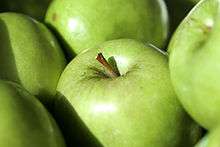
Two of the most comprehensive publications on apple cultivars are: Khanizadeh, S. and J. Cousineau. 1998. "Our Apples/ Les Pommiers de Chez Nous", A Description of Over 250 Apple Cultivars Grown in Eastern and Central Canada Including 400 Coloured Photographs of the Fruits, Flowers and Leaves. Publisher Shahrokh Khanizadeh, 260 p. Ed: S. Khanizadeh. ISBN 0-660-60543-0.
- The New Book of Apples (ISBN 0-09-188398-9) by Dr Joan Morgan of The National Fruit Collection and Alison Richards.
- Directory of Apple Cultivars (ISBN 1-874275-40-8) by Martin Crawford of The Agroforestry Research Trust
- For Cider apples - "Cider Apples, The New Pomona" ISBN 978-0-9568994-2-2 by Liz Copas
- Apples (ISBN 0-393-03690-1) by Roger Yepsen. Text of apple history and descriptions with full-color watercolor illustrations of 90 apple varieties by Yepsen. W.W. Norton and Company, New York and London.
- "Old Southern Apples" (ISBN 978-0-939923-37-3) by Creighton Lee Calhoun, Jr.